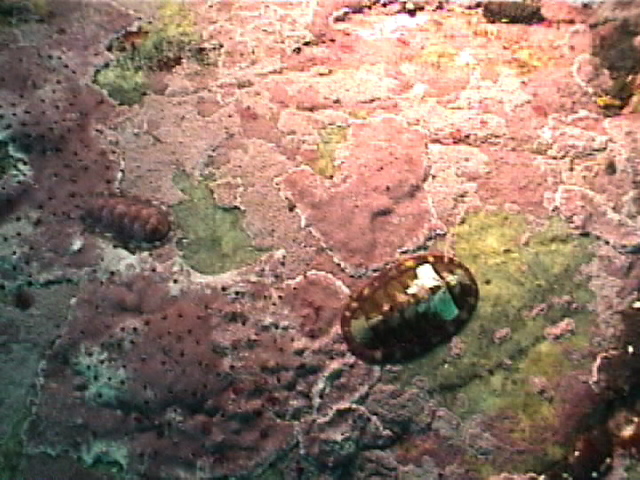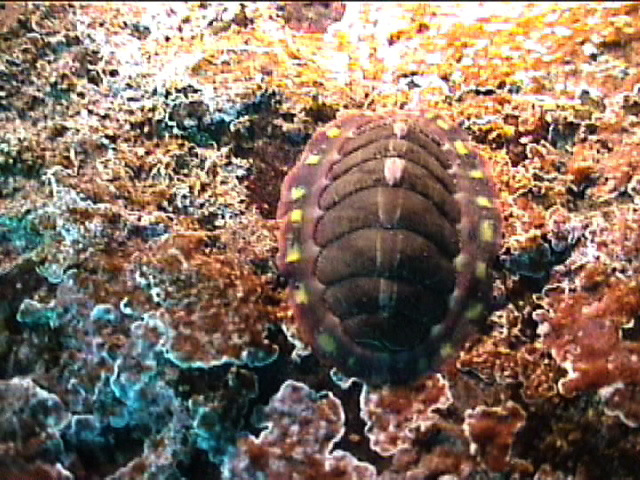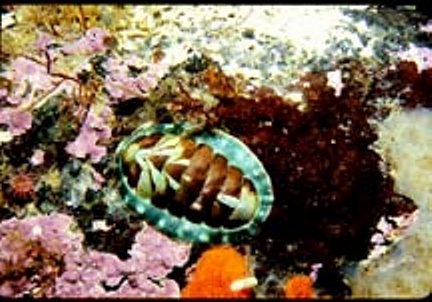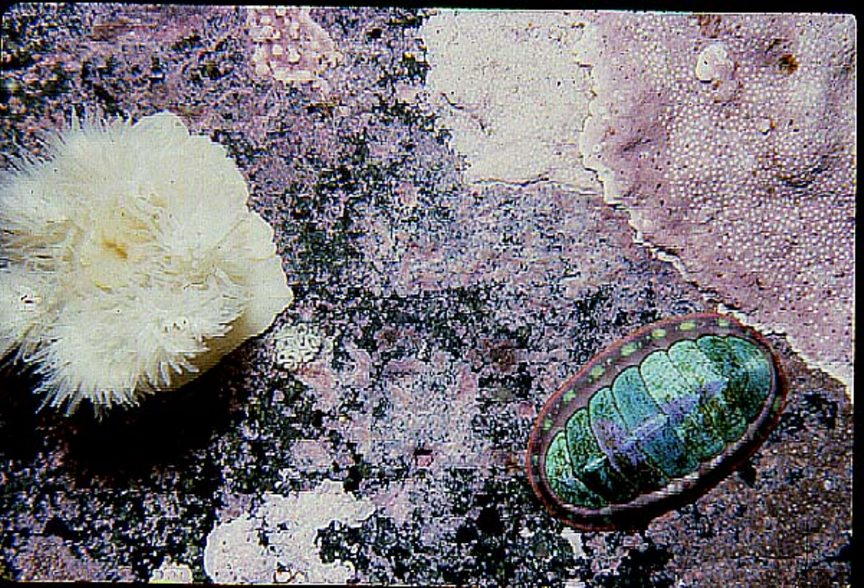Lined chitons are seen frequently by divers in the 5-15 meter depth at Race Rocks. Their color is highly variable, some being a turquoise colour while others are brown with white markings on some of the shell segments as noted on those in this video clip. Observe in particular, the patches of grazed Lithothamnion sp. , the pink encrusting algae.
Characteristics:
 Tonos (stretched/braced) Cell, lineatus (lined/marked with lines).
Tonos (stretched/braced) Cell, lineatus (lined/marked with lines).
The lined chiton eats the surface layers of this encrusting algae, including the film of diatoms and other small organisms on it.
All chitons have a muscular foot for locomotion, a complete digestive tract from the mouth to the anus, a calcium carbonate shell with 8 overlapping plates. This is produced by the mantle, where organs are suspended in coelom. A gill extracts oxygen and disposes waste, a chiton exposed to air consumes only 73 percent of the amount it does when submerged. It remains in oxygen debt until re submersion. Even though the body has bilateral symmetry, the gill numbers on both sides may very well be irregular, asymmetrical.
 Physical Description: The lined chiton- Tonicella lineata -covered by 8 smooth plates,. Endless colour variations exist. The girdle around the plates is smooth and leathery, often with a row of lighter spots or bands. Size up to 5 cm long.
Physical Description: The lined chiton- Tonicella lineata -covered by 8 smooth plates,. Endless colour variations exist. The girdle around the plates is smooth and leathery, often with a row of lighter spots or bands. Size up to 5 cm long.
 It is brightly colored, having a zigzagging dark black/ brown lines over a background of yellow, orange, pink, orchid, and lavender predominate. This aids in its camouflage around the Lithothamnion coralline algae, where it is usually found.
It is brightly colored, having a zigzagging dark black/ brown lines over a background of yellow, orange, pink, orchid, and lavender predominate. This aids in its camouflage around the Lithothamnion coralline algae, where it is usually found.
Geographical Range: Aleutian Islands to San Miguel Island, CA, Sea of Okhotsk, Northern Japan
Habitat: They live on rocks covered with coralline algae that are in the low intertidal or subtidal zone. They can also be found in urchin burrows in the rock.
Feeding: They eat encrusting coralline algae.
Predators:Predators of this invertebrate are sea stars, Pisaster ochraceus and Leptasterias hexactis. Harlequin ducks, and the river otters..
 Reproduction: Dioecious broadcast spawners. Spawning occurs in the spring. The males release their sperm into the water while exhaling waste water. Females release a stream of green eggs. Larvae metamorphose into juveniles approximately 12 hours after having settled on coralline algae.
Reproduction: Dioecious broadcast spawners. Spawning occurs in the spring. The males release their sperm into the water while exhaling waste water. Females release a stream of green eggs. Larvae metamorphose into juveniles approximately 12 hours after having settled on coralline algae.
Adaptations: Larval development stops unless the larva settles on coralline algae, which is its food source. This alga also acts as camouflage, as the chiton is often of the same colour.
Possible Further Studies:
The behavior in different depths.
The reproduction cycle of the lined chitons.
Kingdom Animalia
Phylum Mollusca
Class Polyplacophora
Order Neoloricata
Suborder Ischnochitonina
Family Ischnochitonidae
Genus Tonicella
Species lineata
Common Name lined chiton
- References:
http://www.wallawalla.edu/academics/departments/biology/rosario/inverts/Mollusca/Polyplacophora/Tonicella_lineata.html
Ecology and reproductive biology of Tonicella lineata (Wood, 1815)(Mollusca-Polyplacophora), by JR Barnes, 1972
The larval settling response of the lined chiton Tonicella lineata, by J. R. Barnes and J. J. Gonor, MARINE BIOLOGY, Volume 20, Number 3, page 259-264, 1973
http://wikis.evergreen.edu/marinelife1011/index.php/Tonicella_lineata
Andy Lamb and Bernard P. Hanby, Marine Life of the Pacific Northwest, Harbour Publishing p. 176
Adam Sedgwick , Magazine: Proceedings of the Royal Society of London, Vol. 33, (1881 – 1882), pp. 121-127
Morris, R.H. et al. Intertidal Invertebrates of California. (Stanford: Stanford University Press, 1980)
| Other Members of the Phylum Arthropoda at Race Rocks |
and Image File |
 The Race Rocks taxonomy is a collaborative venture originally started with the Biology and Environmental Systems students of Lester Pearson College UWC. It now also has contributions added by Faculty, Staff, Volunteers and Observers on the remote control webcams. The Race Rocks taxonomy is a collaborative venture originally started with the Biology and Environmental Systems students of Lester Pearson College UWC. It now also has contributions added by Faculty, Staff, Volunteers and Observers on the remote control webcams.
December 2001 – Bassam( Jarbawi (PC year 27) |
